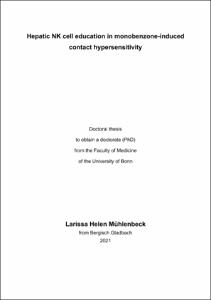Hepatic NK cell education in monobenzone-induced contact hypersensitivity

Hepatic NK cell education in monobenzone-induced contact hypersensitivity

| dc.contributor.advisor | Hartmann, Gunther | |
| dc.contributor.author | Mühlenbeck, Larissa Helen | |
| dc.date.accessioned | 2021-05-07T12:28:57Z | |
| dc.date.available | 2021-05-07T12:28:57Z | |
| dc.date.issued | 07.05.2021 | |
| dc.identifier.uri | https://hdl.handle.net/20.500.11811/9072 | |
| dc.description.abstract | Contact hypersensitivity (CHS) mimics atopic dermatitis in a mouse model where haptens are applied to the skin. Several haptens are reported to induce CHS, but as indicated by the comparison of DNFB, Oxa and MBEH, not all of them activate, involve, and require the same immune cell subpopulations. Whereas hepatic tissue-resident CD49a+ NK cells are required for Oxa-induced CHS, MBEH was reported to depend on hepatic CD49b+ innate cells. This study identifies the hepatic innate immune cells found to develop adaptive features upon in vivo MBEH sensitization as neither ILC1, nor CD49a+ NK cells, but mature conventional NK cells (cNKs). Upon adoptive transfer and elicitation, mice receiving hepatic cNK cells from sensitized mice responded similar to mice that had been sensitized to MBEH. These mice mounted a stable recall response, whereas transfer of hepatic CD49a+ NK cells from sensitized mice could not provide naïve mice with a recall response upon elicitation. Thus, these transfer experiments clarify that only the hepatic cNK cells develop a gain of function by in vivo sensitization with MBEH. Similarly, in vitro exposure to MBEH of cNK cells, followed by adoptive transfer into naïve recipient mice, was sufficient to cause ear swelling upon MBEH elicitation. The comparison of immune cell recruitment in the liver, ILN, and ear, and measurement of the cytokine/chemokine levels in the elicited ear and serum during MBEH-induced CHS are consistent with previous reports on CHS and highlighted the importance of TNF-α, CCL17, IL-1β, GM-CSF, IP-10, IL-18, and type I IFN locally at the elicitation target site (ear). By RNA single cell sequencing we identified that all clusters of lineage negative hepatic NK1.1+ cells share the same transcriptome before (d0) and after (d7) MBEH sensitization. However, during and one day after sensitization with MBEH (d1, d2, d3, d4), hepatic cNK cells exhibited substantial changes in numerous levels of transcripts known to be associated with NK cell activation and effector function, virus-induced processes and ROS, while genes associated with melanin biosynthesis were strongly repressed. Epigenetic analysis of in vivo sensitized hepatic cNK cells showed chromatin modifications, including genes involved in the IFN-γ response and cell killing. These epigenetic changes suggest that MBEH application to the skin induces long-term modifications of hepatic cNK cells that seem to drive potent recall responses towards this specific hapten. | en |
| dc.language.iso | eng | |
| dc.rights | In Copyright | |
| dc.rights.uri | http://rightsstatements.org/vocab/InC/1.0/ | |
| dc.subject | NK | |
| dc.subject | natural killer cell | |
| dc.subject | monobenzone | |
| dc.subject | hapten | |
| dc.subject | CHS | |
| dc.subject.ddc | 610 Medizin, Gesundheit | |
| dc.title | Hepatic NK cell education in monobenzone-induced contact hypersensitivity | |
| dc.type | Dissertation oder Habilitation | |
| dc.publisher.name | Universitäts- und Landesbibliothek Bonn | |
| dc.publisher.location | Bonn | |
| dc.rights.accessRights | openAccess | |
| dc.identifier.urn | https://nbn-resolving.org/urn:nbn:de:hbz:5-62184 | |
| ulbbn.pubtype | Erstveröffentlichung | |
| ulbbnediss.affiliation.name | Rheinische Friedrich-Wilhelms-Universität Bonn | |
| ulbbnediss.affiliation.location | Bonn | |
| ulbbnediss.thesis.level | Dissertation | |
| ulbbnediss.dissID | 6218 | |
| ulbbnediss.date.accepted | 14.04.2021 | |
| ulbbnediss.institute | Medizinische Fakultät / Institute : Institut für Klinische Chemie und Klinische Pharmakologie | |
| ulbbnediss.fakultaet | Medizinische Fakultät | |
| dc.contributor.coReferee | Burgdorf, Sven | |
| ulbbnediss.contributor.gnd | 1073302237 |
Files in this item
This item appears in the following Collection(s)
-
E-Dissertationen (1939)




